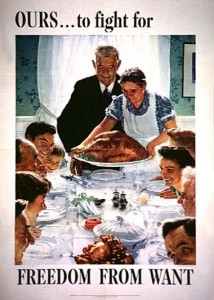We are blessed to have a wonderful art museum in Dayton. Sure, it doesn’t have the extensive collection one can find in a larger city, but there’s more here than one might think. The Dayton Art Institute is housed in a beautiful, 1930’s Italian-villa-styled building, and it’s small enough to see in one day without feeling overwhelmed.

Freedom from Want, one of Rockwell's Four Freedoms works
But one of the best things about the Dayton Art Institute is the variety and quality of traveling exhibitions it hosts. The current visiting exhibition is American Chronicles: the Art of Norman Rockwell, which I had the privilege to see last week. One of the U.S.’s most-loved illustrators, Rockwell is most well-known for his familiar Saturday Evening Post magazine covers. What I didn’t know before, and found amazing, was that he sold work to Boys’ Life, the official magazine of the Boy Scouts, at age seventeen, and became the publication’s art director at age nineteen.
It was fascinating to see the progression of his work, especially the original works in full size, and they present a social commentary that parallels our cultural history throughout the twentieth century, starting with his depictions of an innocent childhood for Boys’ Life, to his beloved “Four Freedoms” works that were sold as prints during World War II to entice people to buy war bonds, to his later works that highlighted current events like racial tensions in the South in the 1960s.

The Art Critic
One interesting addition to the exhibit was a slide presentation that showcased Rockwell’s depiction of the “typical” American family as reflected in television, and how this changed over decades. The slide show begins with Leave it to Beaver, a family headed by a married dad with a stay-home mom, children and grandparents. The presentation touches on blended families (The Brady Bunch), a racially-mixed and adoptive family (Diff’rent Strokes), and non-traditional families (Full House) and asks audiences to consider how Rockwell’s art influenced these other areas of pop culture.
Having a degree in Art and studied painting, I could especially appreciate the layering in the paint, and how many times Rockwell must have let it dry, then added on another layer of detail. This is something that can’t be seen in a print, no matter the quality. I also liked seeing one part of the exhibit that showed the progression of a single piece, starting with his research (this was one of his civil rights commentary works), a photo of the models posing for his initial sketches, his preliminary charcoal drawings. It then showed an early rough painting, and concluded with the final, finished piece.
Regardless of whether or not you have training in art or an interest in U.S. history, the American Chronicles exhibit is well worth seeing. It’s here through February 5th. For hours, admission, and more information, see the Dayton Art Institute website.
If you’re in the area, have you seen the exhibit? If not, have you seen anything like this in your home town?
More at the My Town Monday blog
Images are under copyright, and are displayed under Fair Use as explained on this Wikipedia page


